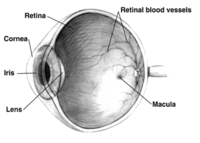
Photo from wikipedia
While color fundus photos are used in routine clinical practice to diagnose ophthalmic conditions, evidence suggests that ocular imaging contains valuable information regarding the systemic health features of patients. These… Click to show full abstract
While color fundus photos are used in routine clinical practice to diagnose ophthalmic conditions, evidence suggests that ocular imaging contains valuable information regarding the systemic health features of patients. These features can be identified through computer vision techniques including deep learning (DL) artificial intelligence (AI) models. We aim to construct a DL model that can predict systemic features from fundus images and to determine the optimal method of model construction for this task. Data were collected from a cohort of patients undergoing diabetic retinopathy screening between March 2020 and March 2021. Two models were created for each of 12 systemic health features based on the DenseNet201 architecture: one utilizing transfer learning with images from ImageNet and another from 35,126 fundus images. Here, 1277 fundus images were used to train the AI models. Area under the receiver operating characteristics curve (AUROC) scores were used to compare the model performance. Models utilizing the ImageNet transfer learning data were superior to those using retinal images for transfer learning (mean AUROC 0.78 vs. 0.65, p-value < 0.001). Models using ImageNet pretraining were able to predict systemic features including ethnicity (AUROC 0.93), age > 70 (AUROC 0.90), gender (AUROC 0.85), ACE inhibitor (AUROC 0.82), and ARB medication use (AUROC 0.78). We conclude that fundus images contain valuable information about the systemic characteristics of a patient. To optimize DL model performance, we recommend that even domain specific models consider using transfer learning from more generalized image sets to improve accuracy.
Journal Title: Diagnostics
Year Published: 2022
Link to full text (if available)
Share on Social Media: Sign Up to like & get
recommendations!